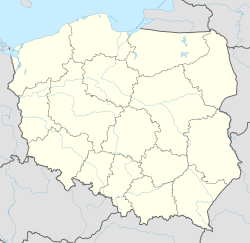Susz
Susz | |
|---|---|
 Centre of the town | |
| Coordinates: 53°43′12″N 19°20′14″E / 53.72000°N 19.33722°E | |
| Country | |
| Voivodeship | Warmian-Masurian |
| County | Iława |
| Gmina | Susz |
| Area | |
• Total | 6.67 km2 (2.58 sq mi) |
| Population (2006) | |
• Total | 5,610 |
| • Density | 840/km2 (2,200/sq mi) |
| Time zone | UTC+1 (CET) |
| • Summer (DST) | UTC+2 (CEST) |
| Postal code | 14-240 |
| Vehicle registration | NIL |
| Voivodeship roads | |
| Website | http://www.susz.pl |
Susz [suʂ] (German: Rosenberg in Westpreußen) is a town in Iława County, Warmian-Masurian Voivodeship, in northern Poland, with 5,610 inhabitants (2006).
Geographical location
[edit]Susz is situated on the northern and western shores of Suskie Lake in the Powiśle region about 26 kilometres (16 miles) east of Kwidzyn, 48 kilometres (30 miles) south of Elbląg and 130 kilometres (81 miles) south-west of Kaliningrad at an altitude of 114 metres (374 feet) above sea level.
History
[edit]
The town was developed at the site of a former Baltic Prussian settlement named Susse, from which comes the town's Polish name Susz. Throughout its history the town carried a rose in its coat of arms (in German Rosenberg means "rose hill"). In 1454, King Casimir IV Jagiellon incorporated the town and the surrounding region to the Kingdom of Poland upon the request of the Prussian Confederation,[1] and, after the subsequent Thirteen Years' War, from 1466 it was part of Poland as a fiefdom held by the Teutonic Order,[2] which in 1525 was secularized as the Duchy of Prussia. From the 18th century the town, known in German as Rosenberg, was part of the Kingdom of Prussia, and between 1871 and 1945, it was part of the German Reich.
During the Napoleonic Wars, in 1807, the town was occupied by France. In the 19th century, the town's Polish inhabitants were subjected to Germanisation policies. In October 1831, various Polish infantry units of the November Uprising stopped in the town on the way to their internment places.[3] Around 1900, the town had a Protestant church, a Catholic church and a synagogue. The town was the capital of the Rosenberg district in the Prussian Province of West Prussia. According to the census of 1910, Rosenberg had a population of 3,181, of which 3,129 (98.4%) were Germans and 34 (1.1%) were Poles.[4][5][6]
After World War I and the re-establishment of independent Poland, during the ongoing Polish-Soviet War, a plebiscite was held in parts of East Prussia and West Prussia on 11 July 1920 to determine whether the region was to remain in Germany or join the Second Polish Republic. In the Rosenberg district, 33,498 (96.9%) voted to remain in Germany and 1,073 (3.1%) voted for Poland. In the town itself, 2,430 votes were cast in favour of Germany and only 8 votes were cast in favour of Poland. Based on that result, the district, along with the town, was included in the Regierungsbezirk West Prussia within the Prussian Province of East Prussia in Germany.
During World War II, from 26 October 1939 until 1945, Rosenberg was part of Regierungsbezirk Marienwerder in Reichsgau Danzig-West Prussia. The Germans operated a subcamp of the Stutthof concentration camp in the town.[7] During the final stages of the war, the town was captured by the Red Army. After the end of war, the town became again part of Poland under its historic Polish name Susz. After the town had been put under Polish administration, almost all German inhabitants who had remained in the town or had returned were expelled to Germany in accordance with the Potsdam Agreement.
Number of inhabitants by year
[edit]| Year | Number[8][9][10][11] |
|---|---|
| 1788 | 781 |
| 1829 | 1,570 |
| 1831 | 1,295 |
| 1875 | 3,081 |
| 1880 | 3,044 |
| 1885 | 3,055 |
| 1890 | 2,909 |
| 1905 | 3,259 |
| 1925 | 3,280 |
| 1933 | 3,822 |
| 1939 | 4,481 |
| 1943 | 4,440 |
| 2006 | 5,610 |
Transport
[edit]Susz is located at the intersection of voivodeship roads 515 and 521, and there is also a train station there.
Notable residents
[edit]- Artur Fürst (1880–1926), German-Jewish author
- Beata Żbikowska (born 1934), Polish Olympic middle-distance runner
- Krzysztof Trybusiewicz (born 1949), Polish Olympic modern pentathlete
References
[edit]- ^ Górski, Karol (1949). Związek Pruski i poddanie się Prus Polsce: zbiór tekstów źródłowych (in Polish). Poznań: Instytut Zachodni. p. 54.
- ^ Górski, p. 96–97, 214–215
- ^ Kasparek, Norbert (2014). "Żołnierze polscy w Prusach po upadku powstania listopadowego. Powroty do kraju i wyjazdy na emigrację". In Katafiasz, Tomasz (ed.). Na tułaczym szlaku... Powstańcy Listopadowi na Pomorzu (in Polish). Koszalin: Muzeum w Koszalinie, Archiwum Państwowe w Koszalinie. p. 138.
- ^ Landesamt, Prussia (Kingdom) Statistisches (1912). Gemeindelexikon für die regierungsbezirke Allenstein, Danzig, Marienwerder, Posen, Bromberg und Oppeln: Auf grund der ergebnisse der volkszählung vom. 1. Dezember 1910 und anderer amtlicher quellen bearbeitet vom Königlich Preussischen Statistischen Landesamte (in German). verlag des Königlichen Statistischen Landesamts.
- ^ "Rosenberg 10) Westpr". s.meyersgaz.org. Retrieved 2021-07-12.
- ^ "Willkommen bei Gemeindeverzeichnis.de". www.gemeindeverzeichnis.de. Retrieved 2021-07-12.
- ^ "Rosenberg i. Westpreußen (Susz)" (in German). Retrieved 24 October 2020.
- ^ Johann Friedrich Goldbeck: Vollständige Topographie des Königreichs Preußen. Teil II, Marienwerder 1789, p. 10, no. 7.
- ^ Der Große Brockhaus, 15th edition, Vol. 16, Leipzig 1933, pp. 101–102.
- ^ Michael Rademacher: Deutsche Verwaltungsgeschichte Provinz Westpreußen, Kreis Rosenberg (2006).
- ^ August Eduard Preuß: Preußische Landes- und Volkskunde. Königsberg 1835, p. 440, no. 56.





